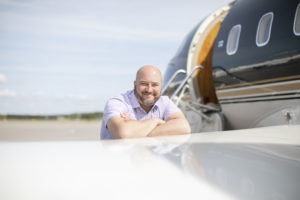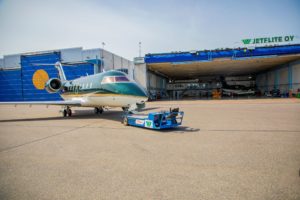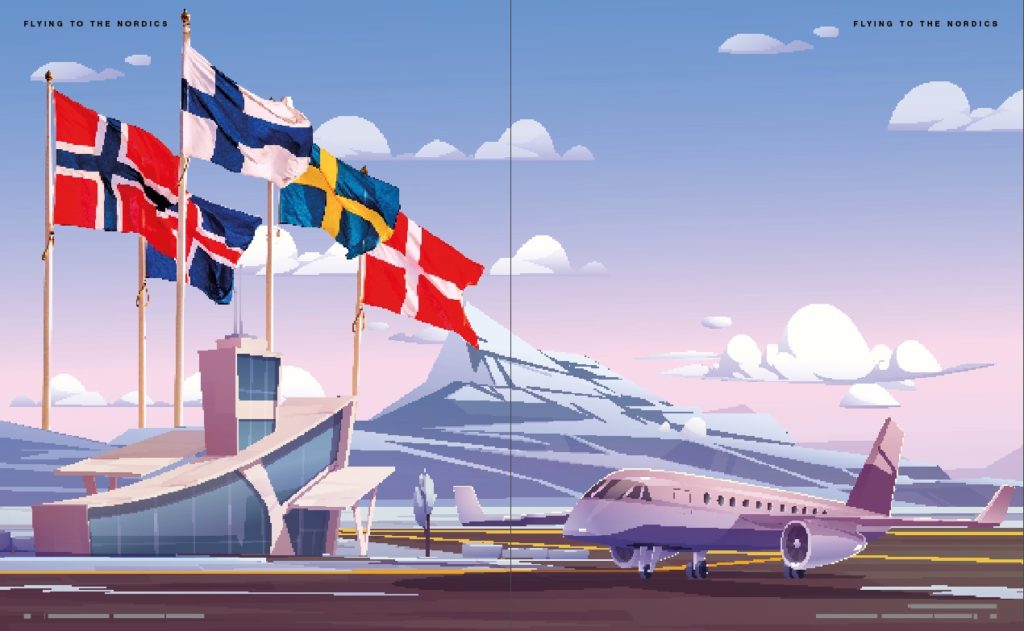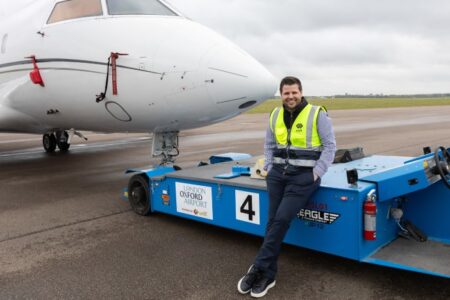The Nordic region consists of Denmark, Norway, Sweden, Finland, and Iceland, as well as the Faroe Islands, Greenland, and Åland. Business aviation is vital for these harder to reach and often isolated places. But how different is the sector in each of the regions?
The busiest time for business aviation varies across the Nordics. Iceland‘s flight activity has been fairly seasonal, mainly concentrated from late spring until the end of autumn, but over the past few years it has been gradually shifting to cover the whole year.

“Summer is always our prime season for business aviation but winter travel to Iceland is now becoming more popular,” says Magni Freyr Guðmundsson, operation chief at SouthAir Iceland, an FBO and private air terminal at Keflavik International Airport.
According to Freyr Guðmundsson there has been a steady growth in business and general aviation in Iceland over the past 15 years. “There has been major setbacks such as the global economic crisis, a volcanic eruption and Covid-19, but business aviation is always quick to recover. More business opportunities as well as the fact that the tourist industry is now the largest industry in Iceland means the sector is on a steady rise,” he says.
Finnish skies are busiest from May to November. “There are lot of festivals during the early summer months and after that the business flying continues. This goes with all business aviation in Finland,” says Sami Simola, ground handling manager at Jetflite Oy, a charter operator based in Finland.
In early December the traffic slows down in Helsinki because of the holiday season and the new year. “But the winter holiday season in northern Finland is very busy,” says Simola. “We have new seasonal operations in Rovaniemi and Kittila to provide a high-end service for private flights. We also provide supervision, coordination and support to almost all Finnish airports so this means that the slow season is quite short.
“There has been a small burst in business but looking at the bigger picture, the Finnish business aviation sector is quite steady.”
Vital for business
The location of Nordic countries mean that despite them being hubs for international businesses, their cities can often be quite difficult to reach, meaning business aviation is crucial to the economy. “Being an island in the middle of the Atlantic we rely on air travel in Iceland,” says Freyr Guðmundsson.
“Business and general aviation is important to us as much as it is important to the people who come here to do business or travel for leisure.”
Simola agrees that business aviation is vital for the region: “Finland is located in the far north of Europe so it is not easy to reach. This is why business aviation is very important to Finland’s economics and to export industry.
“In the Helsinki area there are many international companies which require good connections in and out of Finland. In other cities around Finland there are also companies that are mainly exporting. They need business aviation because commercial connections are not suitable for business purposes.”
Traditionally the south-western coast of Iceland has been the main area for business and general aviation aircraft. “Keflavík International Airport and Reykjavík Airport are the largest airports in the country, so flights will go to these two places,” says Freyr Guðmundsson. “But lately there has been more activity both in the east and north parts of Iceland. We are seeing more GA aircraft making a stopover at these places as it is quite a drive from Keflavík to, for example, Akureyri – the capital of the North.”
Most of the business flights for Finland operate to and from Helsinki. “There are also business operations in other cities like Turku, Tampere, Vaasa and Oulu which are very important business areas,” says Simola.
“During the winter season Lapland becomes the main area thanks to Santa Claus in Rovaniemi and the very popular ski resorts in Kittila and Ivalo.”
Trip planning
According to Simola trip planning for Finland is quite simple. “Almost every airport can provide all the necessary services,” he says. However, traveling to Finland is not without its issues.

“Maybe the biggest challenge is the lack of hangar space in airports around Finland. Only Helsinki can provide hangar space.
“Jetflite has two hangars and a couple of other operators have some availability. The main thing that a planner should understand is that many of the Finnish airports and their services are open with very limited hours.
“It can be very difficult to get answers as the staff are very busy during opening hours. That’s why our supervision service with full credit has become more popular.”
Guðmundsson believes that how easy it is to plan a trip to Iceland depends on the reason for the visit. “If you are here for leisure I advise you plan your trip carefully and don‘t expect to cover too much ground in too short of a time, you will miss out on so many wonderful places to discover.
“During summer the hotels in the Reykjavík area are usually fully booked, so book well ahead if possible. Also, at SouthAir we work with prime booking agents who can work wonders on short notice. Lastly, and this is important – pack for all weather, even during the summer.”
Pandemic priorities
 The market in Iceland slowed down significantly during the Covid-19 pandemic. “Strict regulations of who was allowed to enter the country made it difficult to travel,” says Freyr Guðmundsson. “Yet this did not affect aircraft on overnight stops or quick fuel stops so we managed to service what flights there were going over the Atlantic.
The market in Iceland slowed down significantly during the Covid-19 pandemic. “Strict regulations of who was allowed to enter the country made it difficult to travel,” says Freyr Guðmundsson. “Yet this did not affect aircraft on overnight stops or quick fuel stops so we managed to service what flights there were going over the Atlantic.
“We made sure to keep our customers informed of the ever-changing rules and regulations regarding travel restrictions due to Covid and had to reduce parts of
our operation.
“For example we cut back in Akureyri, as most traffic came through Keflavík International Airport during this time. I would say we went down to perhaps 50% of our usual traffic during the worst months, but now it is steadily getting back to normal.”
Freyr Guðmundsson says, “The Icelandic pandemic team did a great job in restricting the spread of the virus, but obviously restrictions had a negative impact on all aspects
of the flight industry into and out of Iceland.
“One positive is that we are seeing an increase of smaller private aircraft heading our way. I believe that a lot of people realized during the pandemic that private flights were a safer option to use than relying on the airlines.“
The impact of Covid-19 was similar in Finland. “In early 2020 almost everything stopped. The whole aviation industry in Finland had to take actions, decreasing the number of employees and making cutbacks,” says Simola. “The one good thing that came out of this for Jetflite was that the need for reliable and professional ambulance operations increased.”
Almost all restrictions have now been lifted in Finland and according to Simola life is returning to normal.
“The number of casualties has been low in Finland throughout the pandemic. The country has dealt with the pandemic well from a medical point of view.
“But economically there has been a big negative impact. Things are looking a little better but the crisis in Ukraine is not helping the situation.”
Simola is confident that business aviation will be stable in the future. “Growth depends on how the crisis in Ukraine evolves,” he says.
“All the traffic over Russia has stopped. That was a big part of the business aviation sector here as it was for Finnair. We all must adapt to the new situation.”
“Having been working in the industry for over fifteen years I would say that the future looks as good as ever,” says Freyr Guðmundsson. “We are already seeing the number of flights exceed pre-Covid months and the travel industry is back in full swing. We have learned a lot during the past couple of years and will use that experience to be even stronger than before in the future.”





